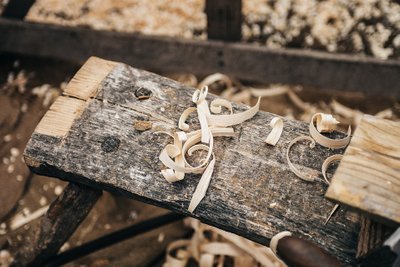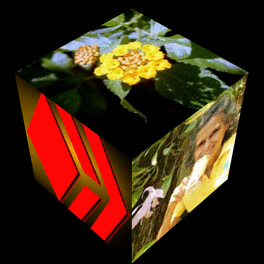
The secret of the timbers
The church was made of mud walls and a palm roof. The inhabitants carefully preserved this temple because it was the place where everyone had been baptized since the time of their great-grandparents.
George and Eusebio were men with a cheerful character. Their skills and creativity in working with wood were unparalleled. They had learned the trade by watching their uncle Francisco. From a very young age, their mother ordered them to work alongside their uncle that he was an old man. When Francisco died and without having any children, his nephews took over the carpentry workshop.
The brothers felt the movement of the ground as they walked and chatted happily. They were barely seconds but the earthquake was of great magnitude. The walls of the houses collapsed and people during of great confusion ran into the streets trying to escape the unforeseen nightmare. Total chaos.
The biological clock had accelerated. The clock on the bell tower had stopped. The times were uneven.

Around 10 a.m. all the survivors were around what was once the structure of the church. Some stood, others knelt, men, women, and children prayed nervously on top of the fallen walls.
Night came and no one had moved from that place. Some went to their destroyed houses and looked for blankets to protect themselves from the cold breeze on a starry night. The weather had changed.
In the early morning, it rained for half an hour making the stay of the villagers in the ruins of the church more agonizing.
Almost nobody could sleep. Fear kept them awake wishing they were alive the next day. At last, it was dawn again. The day was overcast and the sun, always shining, this time was hidden among the clouds. But it was a new day.
Between the puddle and the mess, people were gathering to make campfires and prepare coffee. Others were looking for kitchen utensils, food, and dry blankets among the rubble of the cupboards.
Eusebio and George also helped in the search for anything to make the camps. They went to their carpenter's workshop and brought several work tools with them.
On the way back, passing by the old pulpit, they noticed a huge hole that led to a kind of tunnel. They alerted people to their discovery and together with about ten men they set out to explore it.
When they came out of the tunnel, the bitter expression of those men showed the bad news that would be announced.
Under the church tunnels and passages were leading to various rooms. Despite the earthquake, this subway area seemed to be intact in its stone structure. Photographic portraits of military personnel were on the floor indicating who knew about this place. Shackles, rusty chains, stocks and instruments of torture were found in two other rooms.
After narrating what they had seen, there was a deathly silence.
After hearing the explorers, people began to scatter again. Many remembered the cries of the Crazy Mary who said that beneath the church there were lifeless innocents. Until now no one had paid attention to their chants.
What had the Crazy Mary seen? Could it be true that she was crazy or did the military make her go crazy? -they asked themselves.
The locals were devastated. Surviving to know uncomfortable truths was worse than dying because now they would have to live with them.
Eusebio and George sat down together. They lay down on one of the six timbers pillars of the church that had not broken. Both recognized their uncle's carpentry marks on the pieces of wood that were used for torture. But they would not tell anyone, not even their mother, because they felt pain and shame.

George and Eusebio decided to knock down the timbers of the church to make tables and chairs. Several men joined them for this task.
The work was hard and slow. With axes and hand saws they worked the timber. The priest asked them to make a crucifix and they all agreed. Even knowing the new and rotten history of the church basement, everyone needed a symbol of faith and hope.
So they did. The first piece of timber was a huge crucifix. It was ready in a week. It was beautifully carved by Eusebio.
Later, long wooden tables and benches were ready. All the design work was by George and the finishes were by Eusebio.
The inhabitants of the village were more united than ever. Government aid was not forthcoming and they felt forgotten by the people of the city. But in those days they had themselves and that was enough.
Several weeks passed before a group of deputies and the state governor stepped on the rubble of the village destroyed by the earthquake. They were amazed at the organization of the locals.
They were rebuilding the houses. One by one. A group was cooking. Another group was going to the mountains to collect vegetables. Others cleaned up the rubble and all prayed in the afternoon in front of the wooden crucifix and the stopped clock that marked 9:20, the time of the earthquake.
Nothing was built on the church grounds. This was requested by the inhabitants to the engineers in charge of the reconstruction of the town and this is what happened. Only the square was conditioned. In the center, an altar was made where they placed the great crucifix and the bell tower clock.
Before the church tunnels were closed, George and Eusebio took out several pieces of wood that were used for torture. With them, they reworked wooden masks with signs of suffering.
Most thought that these masks hinted at the day of the earthquake. And it was true! But they were not the faces of the people of the village but of the men and women who were tortured under the pulpit of the church.
Their masks became famous for their excellent craftsmanship and a city gallery bought them. The money they received was donated to an association of the victims of the military dictatorship. The timber, as if it had a spirit, had atoned for their sins.
George and Eusebio hid forever the secret they discovered about their uncle Francisco's complicity with the military torturers.
They kept for themselves two last and unique pieces of timber that were a winged horse and a rose. They placed them on top of a nameless tombstone, in an anonymous grave in the cemetery. There, every year on the date of the earthquake, the people of the town attended with a lighted candle.


Thanks for reading.
Welcome your comments
Infinite greetings!
© Aug 2020, Marcy Betancourt. All rights reservedStory @marcybetancourt


Hello! Your post was selected by The Ink Well for quality and has received an OCD upvote! Congratulations! Please keep sharing these quality posts.
Wow... I am really much obliged
Twitter Link
I really felt this. Superb story. Congratulations, @marcybetancourt!
Thank you for your reading and comment @gabmr
This is such a beautiful story, @marcybetancourt. Well done. I can almost see the town and the characters. George and Eusebio are painted as people with integrity, and their gesture to do something good for the community shows that did not turn out like their uncle!
I love that line!
I always like to describe so that readers can imagine the places (as I have imagined it too).Hello @jayna.
That's the line that encloses everything. The integrity, the attitude, the symbolism, and the redemption. Also, the literary image of humanization.
I wrote this moment before the end of the story because this way the sentence has more impact.
Thanks for reading and commenting